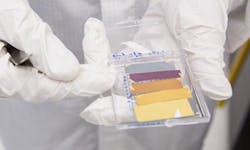Mikhail Kats and Federico Capasso of the School of Engineering and Applied Sciences (SEAS) at Harvard University (Cambridge, MA) have developed a nanometers-thick multilayer film of gold and amorphous germanium that shows produces vivid colors via strong optical interference—and does this when deposited on rough surfaces like paper, creating bright matte colors.1 The film is an outgrowth of their earlier research in which they created similar films, but only for specular surfaces.
Carefully tuning the film's thicknesses can produce a bright matte solid pink or a vivid blue. This finding suggests that the ultrathin coatings could be applied to essentially any rough or flexible material, from wearable fabrics to stretchable electronics.
Tiny amounts of material
"This can be viewed as a way of coloring almost any object while using just a tiny amount of material," says Capasso. Because the entire film thickness is much less than the wavelength of visible light, the coating exhibits less color change as a function of viewing angle than standard optical interference films.
The method of fabrication produces different effects: using an electron-beam evaporator produces some angular color change, while using a reactive sputterer produces no angular color change because the coating is more conformal.
Many different pairings of metal are possible, too. "Germanium's cheap. Gold is more expensive, of course, but in practice we're not using much of it," says Kats. Capasso's team has also demonstrated the technique using aluminum.
"This is a way of coloring something with a very thin layer of material, so in principle, if it's a metal to begin with, you can just use 10 nanometers to color it, and if it's not, you can deposit a metal that's 30 nm thick and then another 10 nm," says Kats. "That's a lot thinner than a conventional paint coating that might be between a micron and 10 microns thick."
Source: http://www.seas.harvard.edu/news/2014/12/hands-on-crafting-ultrathin-color-coatings
REFERENCE:
1. Mikhail A. Kats and Federico Capasso, Applied Physics Letters (2014); http://dx.doi.org/10.1063/1.4896527

